Lec#13: Vergence Treatment Part 2
1/54
There's no tags or description
Looks like no tags are added yet.
Name | Mastery | Learn | Test | Matching | Spaced |
|---|
No study sessions yet.
55 Terms
what is the goal of training septums and apertures?
- increase amplitude and facility of both N and P fusional vergence response
- decrease latency of fusional vergence response
- increase speed of fusional vergence response
aperture rule is used to train what level of fusional vergence?
step vergence
equipment for training with aperature?
- aperture and cards
- flip lenses
- flip prisms
- pointer
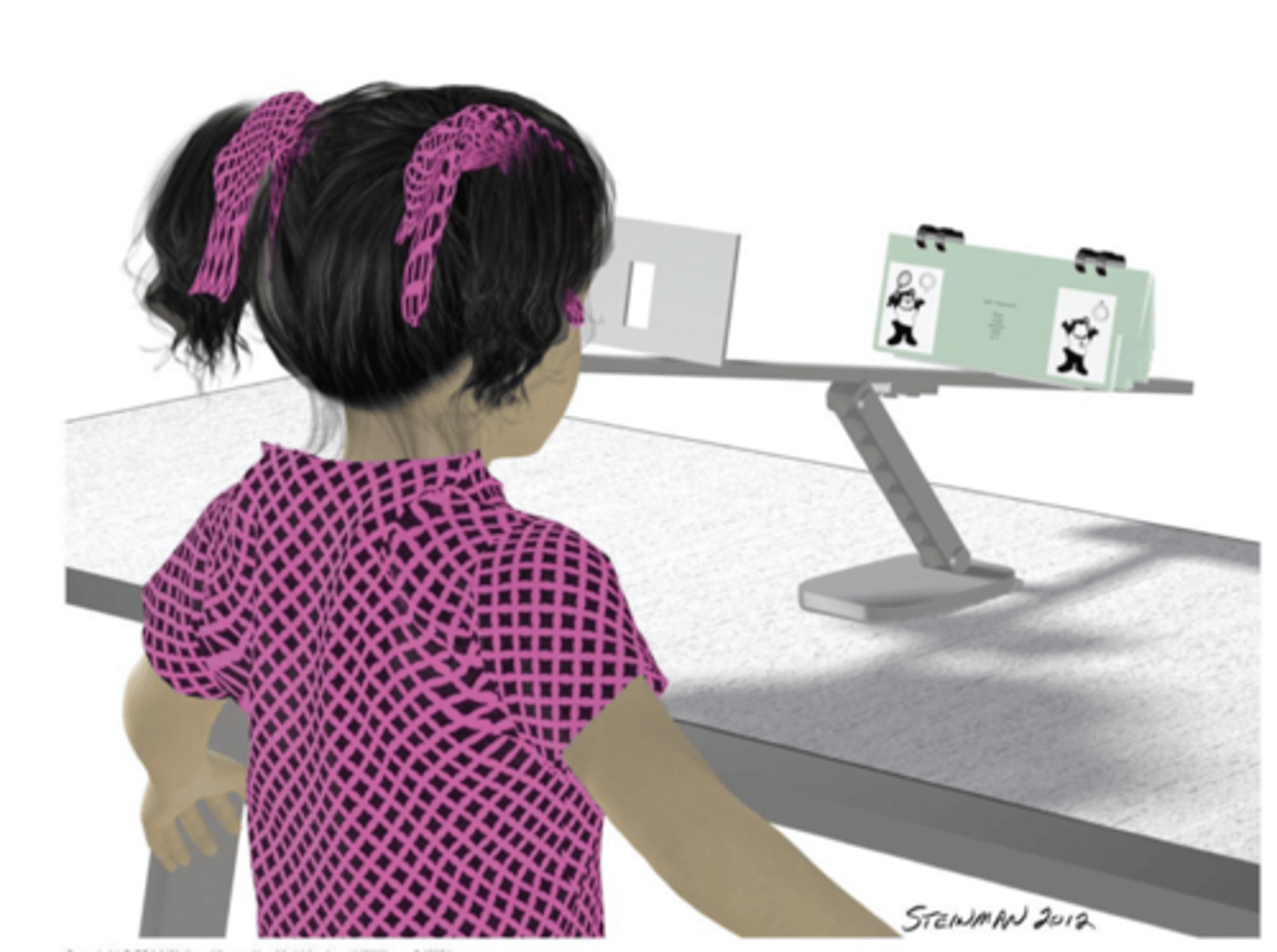
if training convergence on the aperature rule adding what lenses will make this harder for the pt?
BIMBOP
Easy way to remember is that when you are training a CI patient, you are training BO because you are forcing their eyes to converge since the image moves from the base inward. Because of this BO is harder. And so BOP plus is harder
which is used to train divergence on the aperture rule?
double aperture used for divergence training
single aperture/ window used for convergence
aperture cards consists of 12 cards which a varying disparities of...?
2.5 to 30pd
cards have either second degree or third degree fusion
how do you train convergence using the aperture rule?
- pt places nose at end of aperture rule
- use kinesthetic awareness of looking close to help pt fuse
- once fusion is achieved, ask pt about clarity, anti-suppression, and depth (inner circle comes closer)
- hold for 10 seconds
- look away and look back to regain fusion as quickly as possible
for divergence you would use double aperture
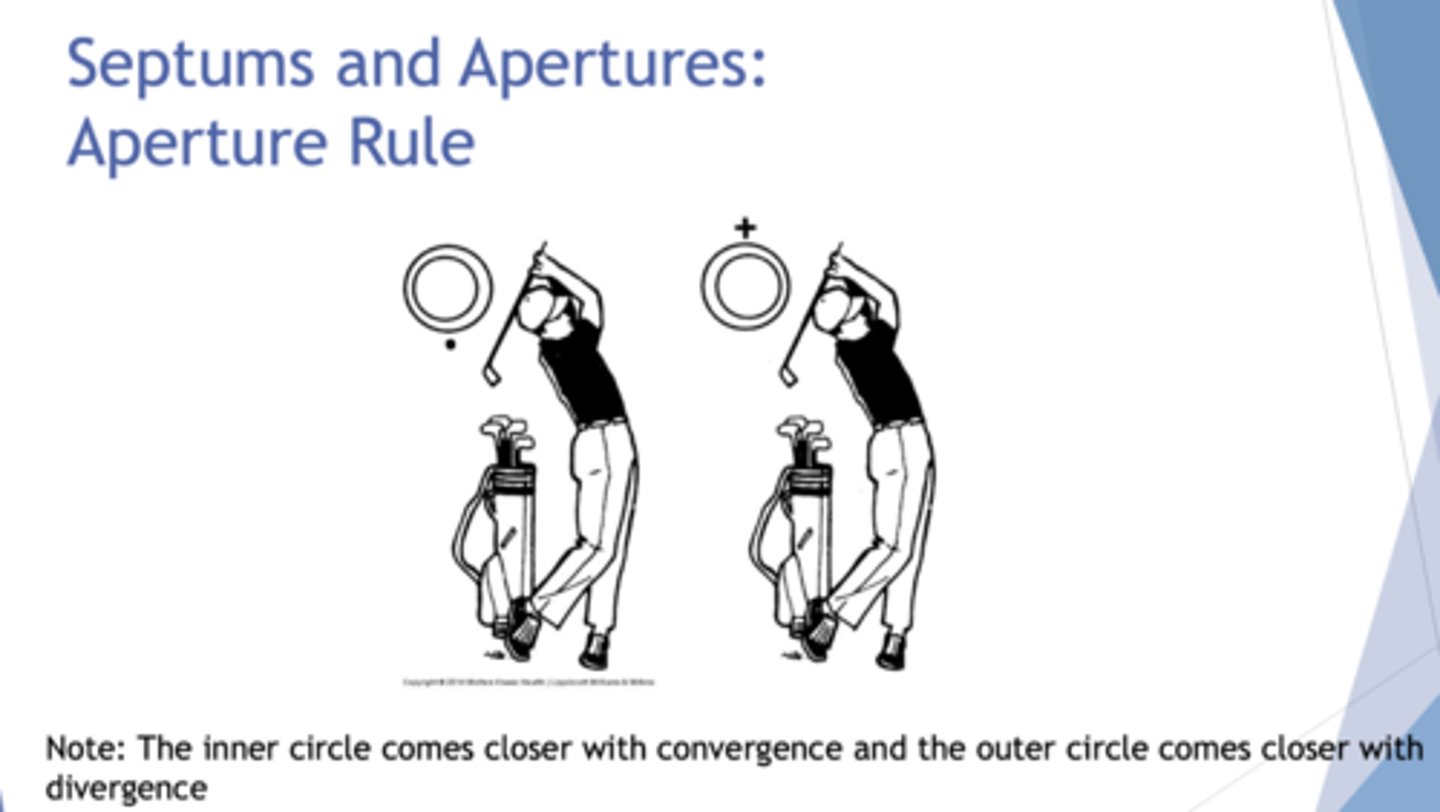
you are training pt with the aperture rule if they state they see the inner circle coming closer, then you are training
a. convergence
b. divergence
a. convergence
you are training pt with the aperture rule if they state they see the outer circle moving closer, then you are training
divergence
formula for calculating the demand for aperture rule?
card number* 2.5
each card number is the distance in cm between the center of the targets
ex pt fuses card #1
what is the target demand if pt is at 40cm?
1cm/ 0.4m= 2.5pd
which is more difficult
a. tranaglyph and vectogram
b. aperture
aperture is harder b/c there is always a divergence or convergence demand
what is the correct endpoint for aperture rule training?
pt is able to achieve clear single binocular vision with all 12 cards (30pd base out) for convergence and up to card 7 ( 17.5 base in) for divergence
if pt is struggling to fuse with the single aperture rule, how can you help them fuse?
BIM BOP
minus lenses or base in prism
the base in prism will allow the pt to converge less
if pt is struggling to fuse with the double aperture rule, how can you help them fuse?
can help by adding plus lenses as this will relax the eyes and diverge the eyes for the pt
or by adding base out prism will allow the eyes to diverge less as the prism will move the image in for the pt
is aperture rule easier or more difficult than the variable vectograms and tranaglyphs?
more difficult b/c theres always a divergence or convergence demand
eccentric circles/ free space fusion cards A trains
a. step vergence
b. smooth vergence
a. step vergence
goals of eccentric circles?
- increase amplitude and facility
- decrease latency of the fusional vergence response
- increase the speed of the fusional vergence response
equipment for eccentric circles?
opaque or transparent eccentric circles card
flip lenses or prisms
pointer
for eccentric circles/ free space fusion cards A
the pt fuses by _________ in front of the place of accommodation (chiastopic fusion) or ____________ diverging (orthopic fusion) beyond the plane of accommodation
converging
diverging
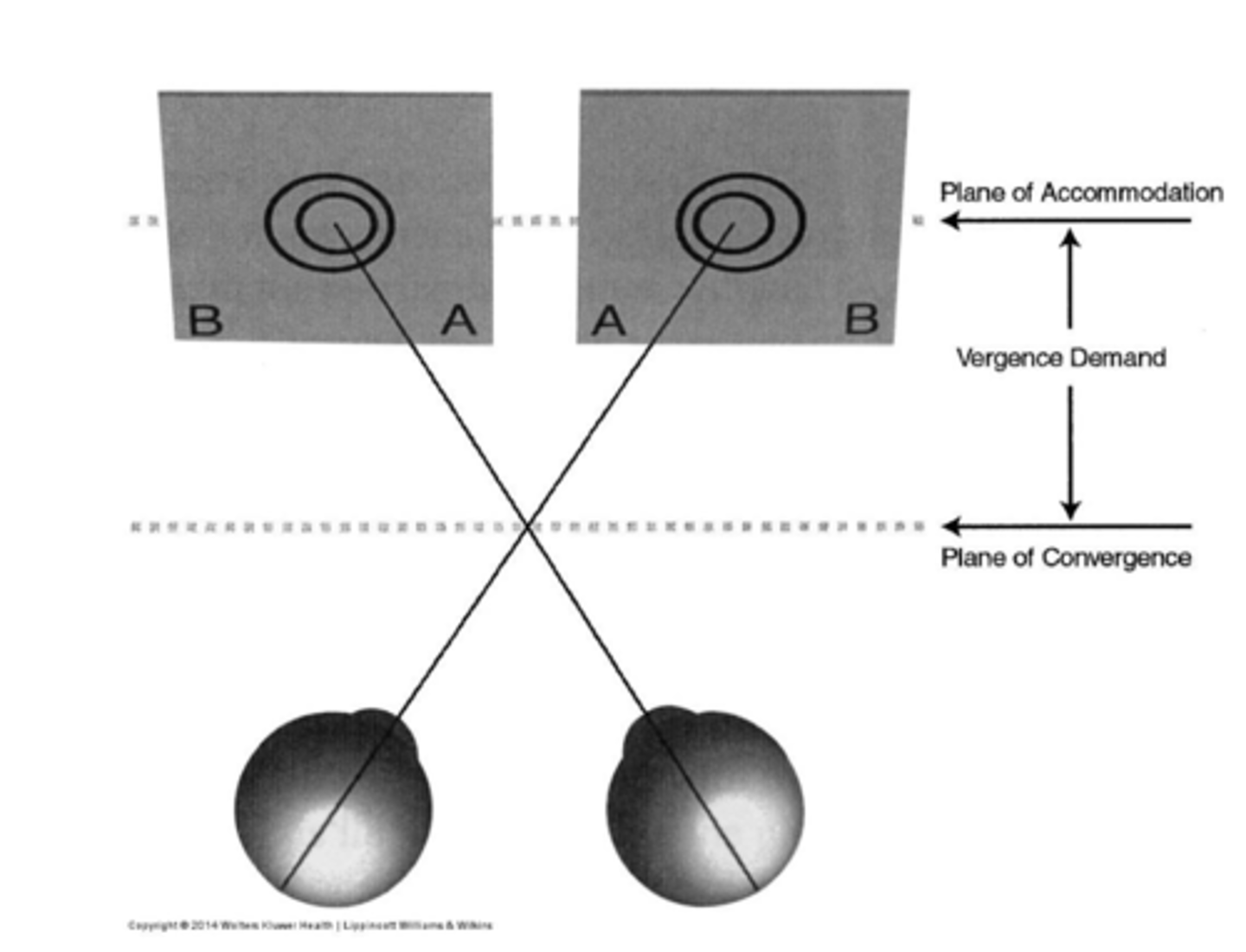
the eccentric card presents a ______ degree fusion stereopsis target.
a. first
b. 2nd
c. 3rd
3rd degree
what is chiastopic fusion
fusion obtained by voluntarily converging to fixate directly two fusible targets, laterally separated in space, such that the right eye directly fixates the left target and the left eye the right target
how is level 1 of eccentric circles trained?
- pt holds opaque cards 40cm away with A's side by side
- ask pt to "cross their eyes"
- if pt is struggling use localization to show the pt where they have to fixate in space to achieve fusion
- hold fusion for 10 seconds
- as the pt to describe the middle set of the circles
how can you load eccentric circles?
have the pt trombone and maintain fusion
have the pt look away and look back to regain fusion. repeat ten times
separate the cards apart 1cm at a time and repeat
_______ fusion occurs when the vergence plane is in front of the cards.
chiastopic
each eye perceives two targets
when pt converges to the appropriate plane the two middle images over lap and become a fused image in the center
- b/c the eccentricity of the inner circles on the cards retinal disparity will be created and the pt should perceive stereopsis
if converging the A's are together the inner circle appears to float ______ due to uncrossed retinal disparity
away
temporal target displacement--> nasal retinal displacement--> uncrossed retinal disparity
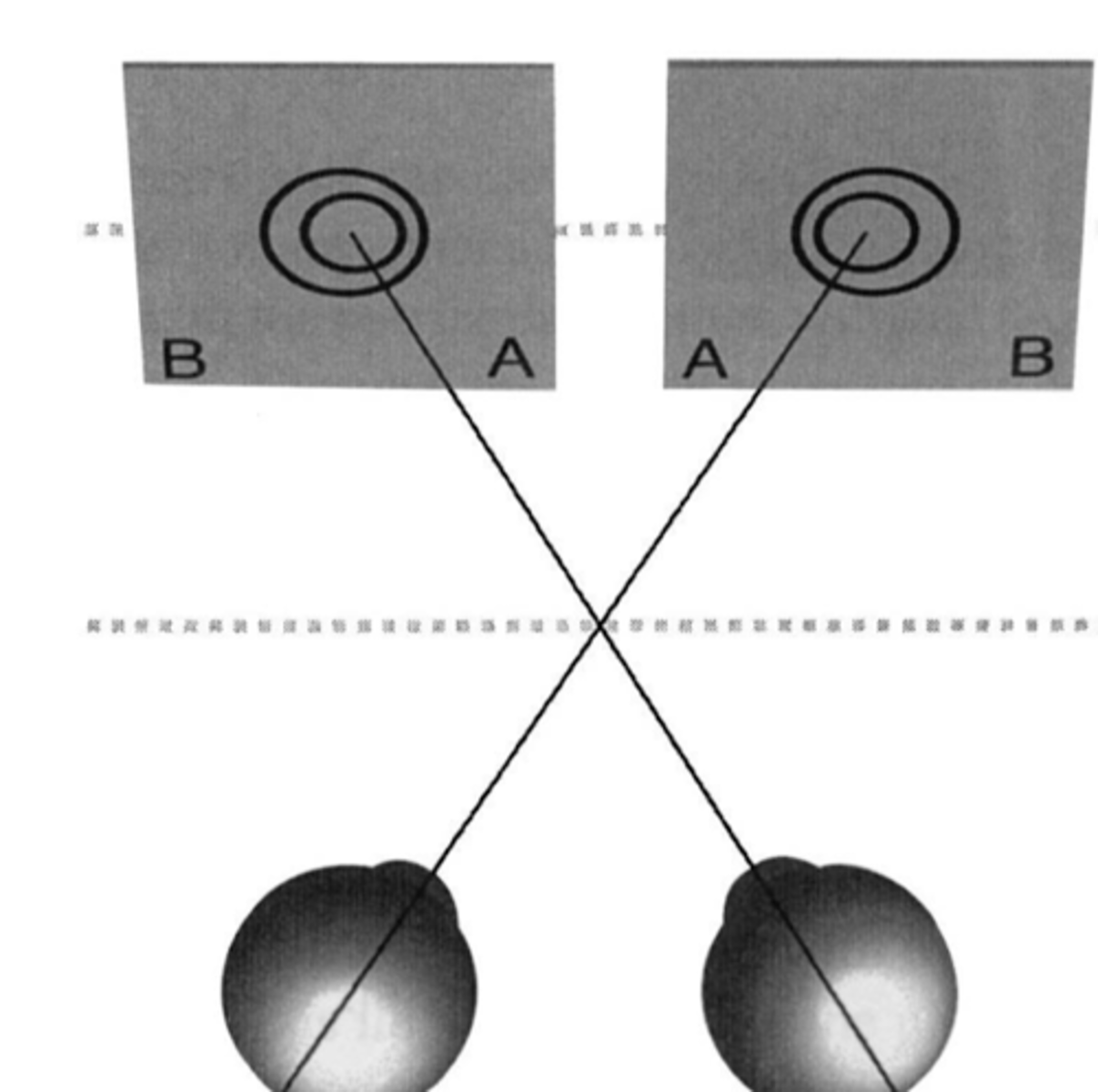
if diverging
and the A's are together, the inner circle appears to float closer due to the crossed disparity (nasal target displacement--> temporal retinal displacement---> crossed retinal disparity
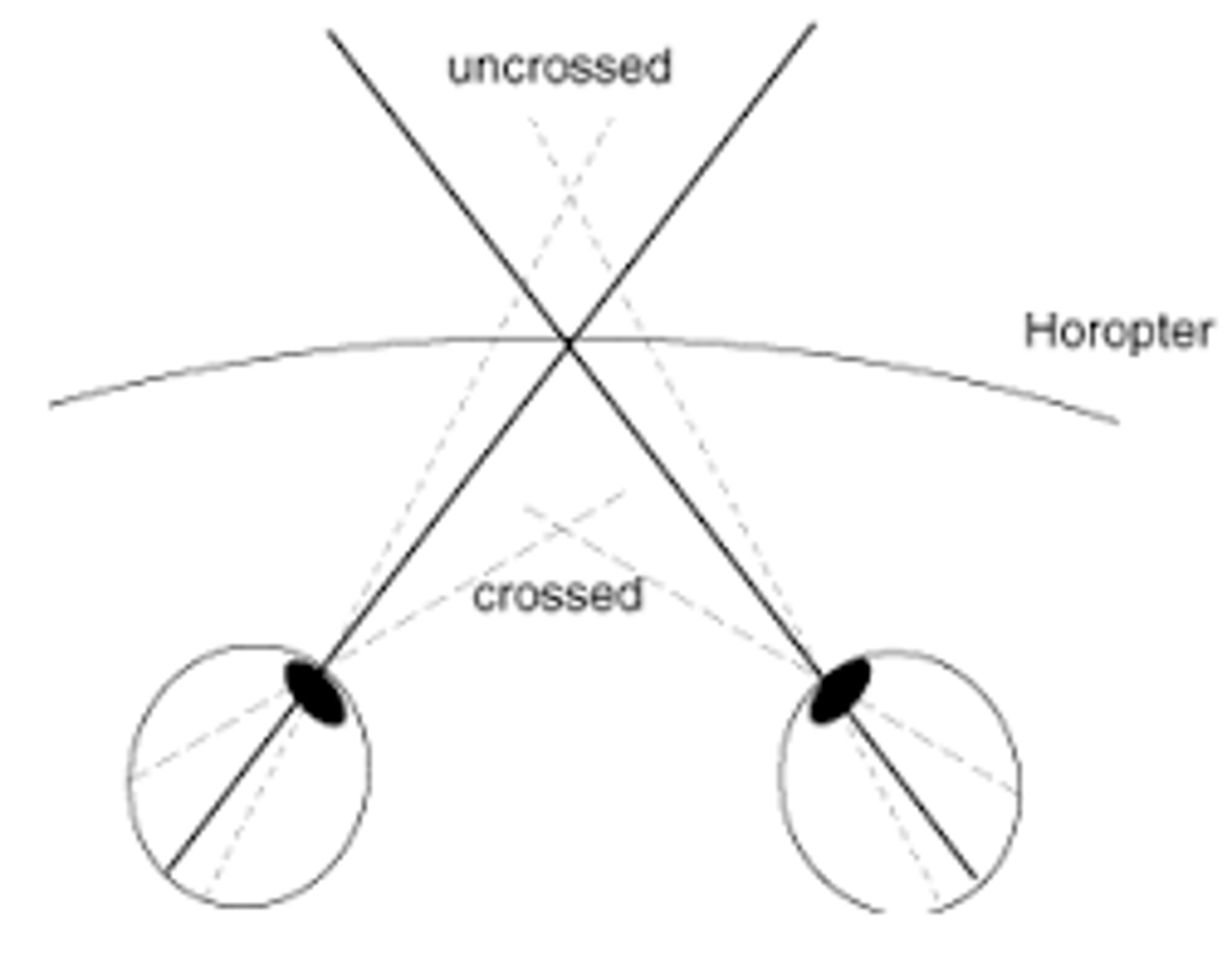
Crossed retinal disparity makes inner circle move __________ pt
a. towards
b. away
towards
Uncrossed makes inner circle move _______ from the pt
a. towards
b. away
away
you are training convergence with eccentric circles. pt states they see the inner circle floating towards them what does they say about the pts eyes? (set up is with A's together)
this is crossed disparity = pt is diverging
the right eye is looking at the right target
the left eye is looking at the left target
if you split the right target in the middle the right eye see's the inner circle mostly to the left side
and thus this is crossed disparity and we know crossed disparity makes things seem closer thus why pt sees the inner circle floating towards them.
you have to instruct pt to try and cross their eyes more to see the inner circle floating away from them aka converging (uncrossed dispairty)
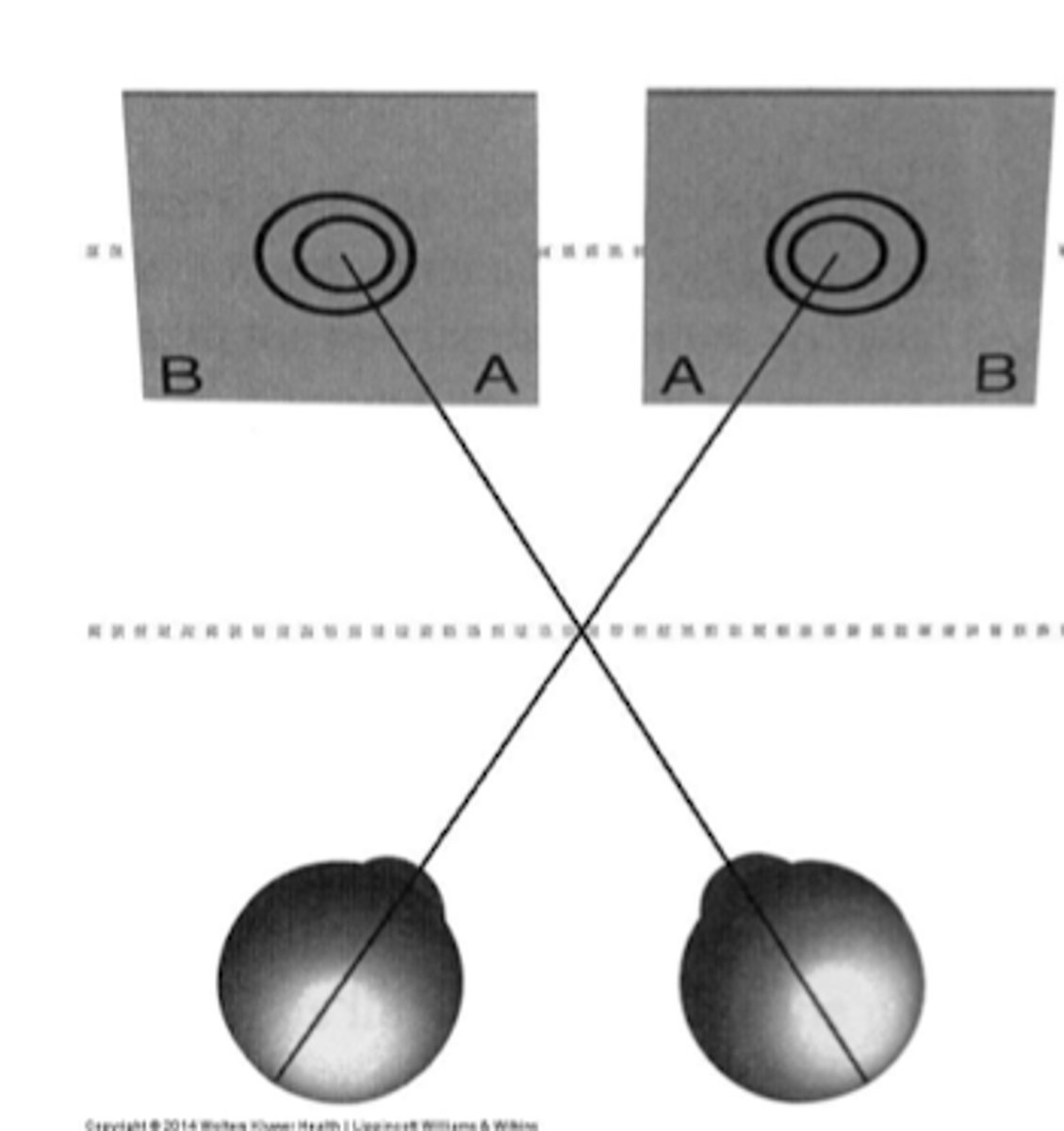
you are training convergence with eccentric circles and set up the cards with the A next to each other. The pt states that they see the inner circle floating away from them, what does this tell us about the pts eye posture?
pt see's inner circles floating away from them we know this is due to uncrossed retinal disparity.
The only way for the pt to see uncrossed disparity is if the right eye is looking at the left target and the left eye is looking at the right target= convergence
if you split the left target down the middle the inner circle is towards the right which is being see by the right eye= uncrossed disparity= inner circle will appear floating away from the pt
convergence --> uncrossed disparity---> circles floating away from the pt
you are training convergence with the B's on the cards set up as next to each other
pt sees the inner circle is floating towards them what does this mean?
floating towards them = crossed retinal disparity and the only way for pt to see the inner circle leaning towards the left with their right eye would be if the right eye was looking at the left target= thus pt is converging
uncrossed is inner circle is floating away from pt = divergence
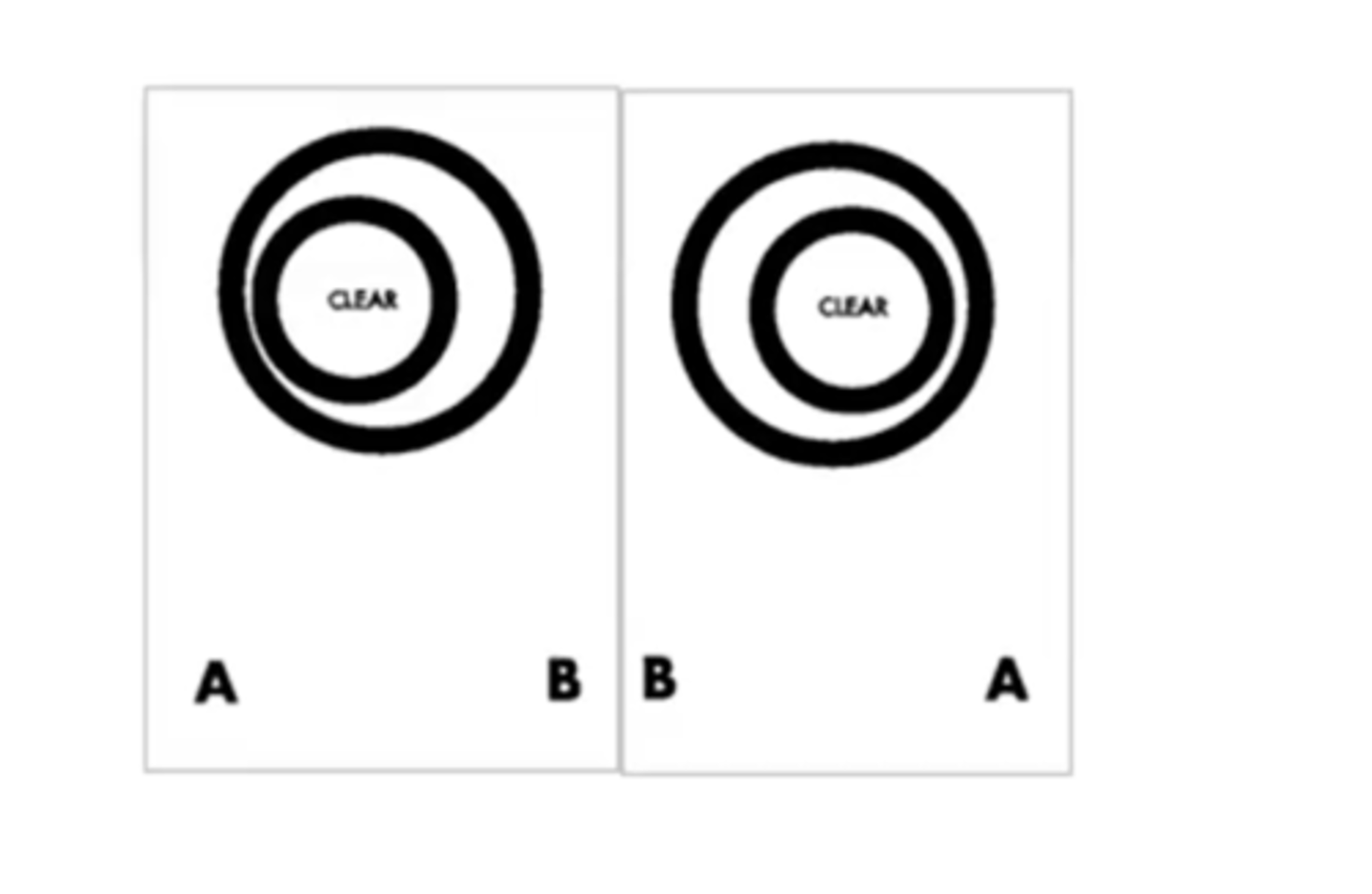
you are training convergence with the B's on the cards set up as next to each other
pt sees the inner circle is floating away from them what does this mean?
floating away= uncrossed retinal
in order for the pt to be seeing uncrossed retinal disparity the right eye would be seeing the inner circle leaning towards the right
and the left eye is seeing the inner circle leaning towards the left
and the only way for them to see that is if the right is looking at the right target and the left eye is looking at the left target.
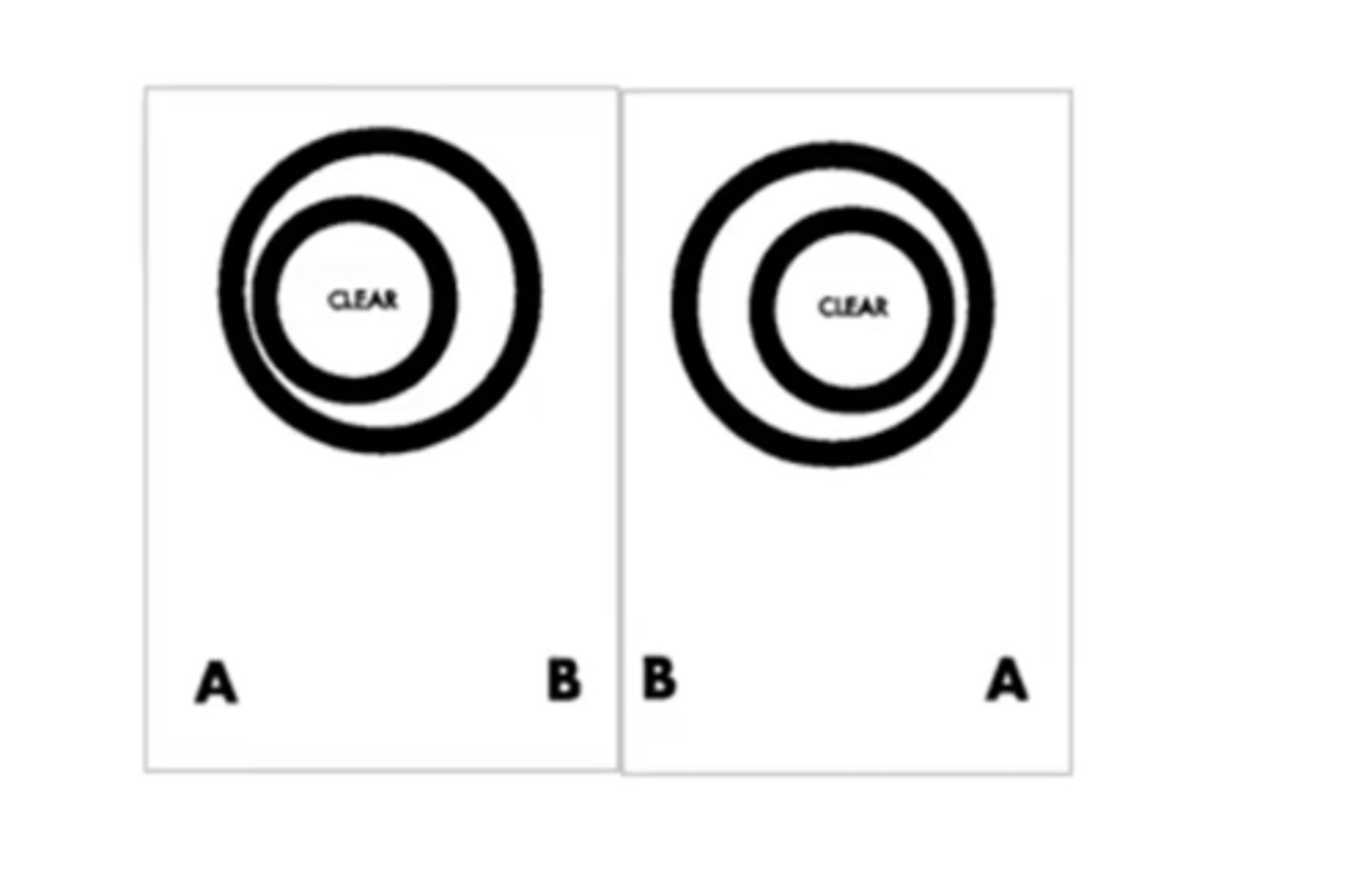
Crossed vs. UnCrossed Disparity.
Objects which produce crossed disparity are in front of the object of focus. Objects which produce uncrossed disparity are behind the object of focus.
when the cards are held with the B's together what changes?
the perception of stereopsis of float will be the opposite
true or false
eccentric circles can used for convergence and divergence depending on what the pt does with their eyes.
TRUE
to have the pt train divergence what do you instruct the pt to do with their eyes?
use clear cards
and the pt is asked to relax or diverge their eyes to achieve fusion
if pt is having trouble wit divergence eccentric circles training then how can you help make it easier?
have the pt fixate a target on the wall through the clear eccentric circles
- the pt should start off standing close to the wall and slowly walk backwards until fusion is achieved
what does level 2 of eccentric circles train?
train vergence facility
how is level 2 eccentric circles performed?
switch between chiastopic fusion (hold of ten seconds) and orthoptic fusion (hold for 10 seconds), alternating back and forth several times
continue to separate cards to increase difficulty
how do you calculate the demand for eccentric circles?
target separation in cm/ training distance in meter
what is endpoint for eccentric circles chiastopic fusion?
what is endpoint for eccentric circles orthopic fusion?
fuse cards up to 12cm (30pd PO at 40cm) apart
fuse cards up to 6 to 8cm (15-20BI apart)
switch between chiasoptic and orthopic fusion with cards held 6cm part for 20cpm
eccentric circles can also be used to train what two oculomotor movements?
- saccades: use two or more sets of cards placed at different gazes
- pursuit integration have the pt move the cards laterally or in a circular motion whole maintaining fusion
what is goal for training with lifesaver cards/ free space fusion cards b
increase positive and negative fusion vergence amplitude and facility
decrease latency
increase speed

you are have your pt converge the life saver card and they see the letters popping towards them what does this mean about their eyes?
they are converging
what is the endpoint for lifesaver circles?
pt is able to achieve chiastopic/ orthopic fusion with all of the targets on the card
- pt is able to switch between chiatopic and orthopic fusion with all targets (facility)
exos you want them to first get better at chiastopic fusion
eso you want them to first get better at orthopic fusion
the brewster stereoscope is used to train what fusional vergence level?
step vergence
brewster stereoscope is aka
bioptic and is used for vergence training at distance
brewster is best for training what?
vergence training at distance specifically divergence
what is the brewster stereoscope?
instrument divides physical space into 2 separate areas of visual space, each being visible in one eye
the lenses set the image at optical infinity
same goals

at what distance from the pt does the brewster stereoscope have no accommodative demand?
at 20cm
if you bring the bioptic closer then you can test convergence since you would have a, accommodative demand now
as the target moves closer divergence demand is ________.
is increased and convergence demand decreases
know this; opposite than what you think it would be
how can you make brewster harder for divergerence training?
pt slides card closer and trys to maintain single clear binocular vision
what is the endpoint of brewster stereoscope?
pt achieves single binocular vision with the selected cards at the selected distance
How can you
- supplement fusional vergence technqiue either increasing or decreasing the level of difficulty?
add prisms or lenses during the fusional vergence tests we discussed
can add prism
flippers plus and minus
red/ green or polarized bar reader and corresponding glasses
any binocular target with suppression controls